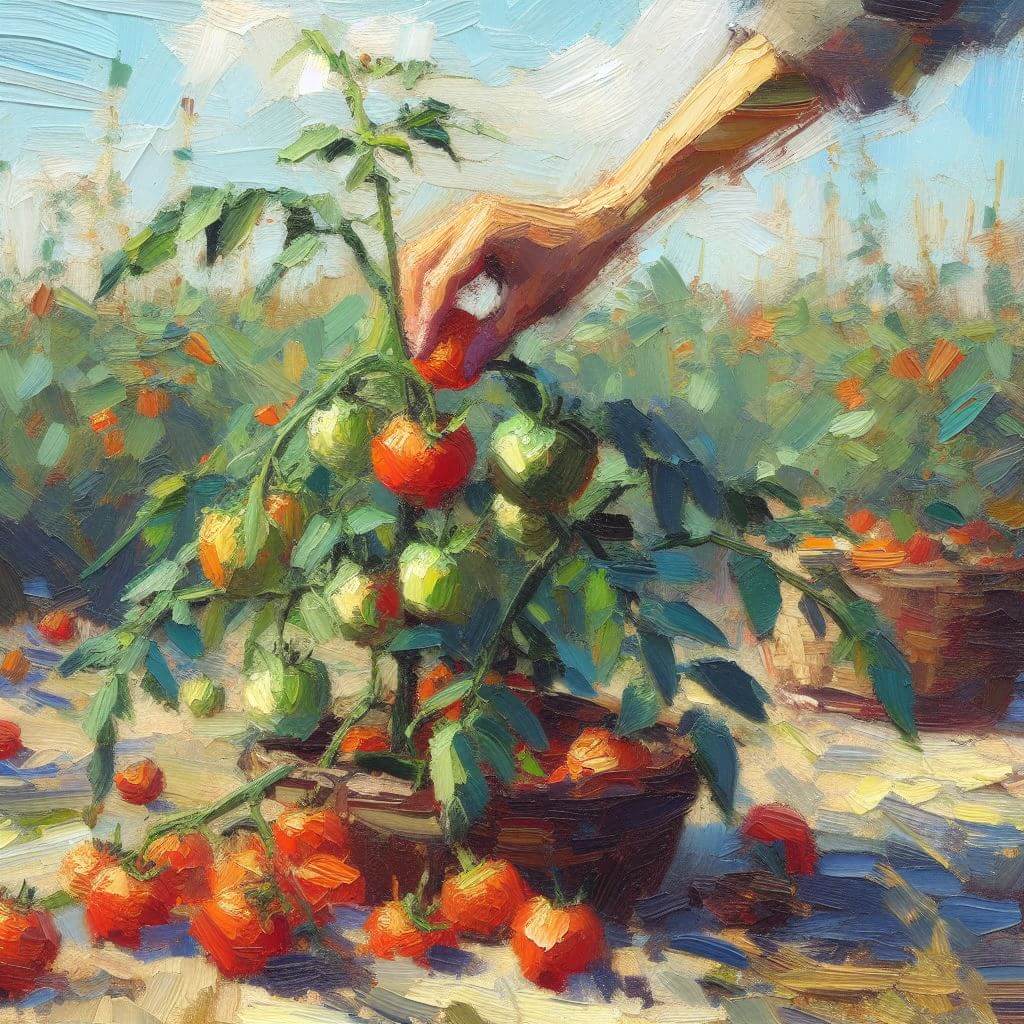
Growing your own food can be a gratifying endeavor, and tomatoes, with their rich flavor and versatile use, are an excellent starting point. Planting tomatoes in Kentucky is particularly beneficial due to the region’s favorable conditions.
Characteristics of Tomatoes
Tomatoes are hailed as a gardener’s favorite. They are sun-loving plants that thrive in warm temperatures and rich, well-draining soil. They are packed with vitamins A, C, and K, and are known for their antioxidant properties. Growing tomatoes not only provides a bounty of fresh produce but also offers the satisfaction of nurturing a plant from seedling to fruit-bearing maturity.
Kentucky’s Favorable Growing Conditions
Kentucky’s climate and soil conditions present an ideal environment for tomato cultivation. The state experiences a moderate climate with warm, humid summers, and mild winters. The soil in Kentucky is typically loamy, which is perfect for tomato plants as it drains well and is rich in organic matter.

When to Plant Tomatoes in Kentucky
Timing is everything when it comes to planting tomatoes. While the state’s climate is generally favorable, planting at the right time can significantly impact the growth and yield of your plants.
In Kentucky, the best time to plant tomatoes is after the last spring frost, which typically falls between April and early May. Planting during this period allows the plants to take full advantage of the growing season and ensures they are not exposed to potentially damaging frost.
The growth of tomatoes can vary depending on when they’re planted. Early planting can lead to an earlier harvest but runs the risk of frost damage. Conversely, later planting reduces the risk of frost but may result in a later harvest.
When to Plant Tomatoes in Kentucky: Region-Specific Recommendations
Western Kentucky
This region includes cities like Paducah and Bowling Green. The climate is slightly milder compared to the rest of the state. Here, the best time to plant tomatoes is in late April to early May, after the risk of frost has passed.
Central Kentucky
This region includes cities like Louisville and Frankfort. The climate is moderate, with a longer growing season. In this region, tomatoes can be planted a bit earlier, around mid to late April.
Eastern Kentucky
This region includes cities like Pikeville and Hazard. The climate here is a bit cooler, especially in the mountainous areas. Therefore, it’s safest to plant tomatoes from early to mid-May when the soil has warmed sufficiently.
Northern Kentucky
This region includes cities like Covington and Florence. It’s influenced by its proximity to the Ohio River and experiences a slightly cooler climate. Here, tomatoes should be planted in late April to early May, after the last expected frost.
Southern Kentucky
This region includes cities like Somerset and London. The climate is slightly warmer with a longer growing season. Here, you can start planting tomatoes a bit earlier, around mid-April, once the danger of frost has subsided.
Remember, these are general guidelines and actual planting times can vary slightly depending on the specific microclimate of your garden and the tomato variety you are planting. Always check local weather forecasts and consult with local garden centers or extension services for the most accurate information.

Guidelines for Planting Tomatoes
Planting tomatoes requires careful planning and execution. Begin by selecting a location that receives at least 6-8 hours of sunlight each day. Prepare the soil by adding compost or a slow-release fertilizer to enrich it with essential nutrients.
Dig a hole deep enough to bury two-thirds of the plant, as this promotes strong root development. Place the tomato plant in the hole, backfill it with soil, and water thoroughly.
Maintaining your tomato plants involves regular watering, staking, or caging to support the plants as they grow, and monitoring for pests and diseases. With careful attention and care, your tomatoes will flourish, providing a rewarding harvest.
Remember, the quality of your tomatoes depends largely on the care you give them throughout their growth cycle. Starting from the right planting time to the right care, every step counts towards a successful tomato harvest.
Tomato Varieties Suitable for Kentucky
Choosing the right variety of tomatoes to plant is just as crucial as knowing when and how to plant them. Luckily, Kentucky’s moderate climate and fertile soil allow for a wide range of tomato varieties to thrive.
Beefsteak Tomatoes: These are large, often used for sandwiches or eaten fresh. They thrive in Kentucky’s warm summer climate. The ‘Big Beef’ variety is a favorite among gardeners for its disease resistance and consistently large fruits.
Cherry Tomatoes: These small, bite-sized tomatoes are perfect for salads or snacking. Varieties like ‘Super Sweet 100’ and ‘Sungold’ are known for their high yield and sweet flavor. They are also quick to mature, making them an excellent choice for those eager to start harvesting.
Roma Tomatoes: Also known as plum tomatoes, these are great for sauces and paste due to their low water content. The ‘San Marzano’ variety is a popular choice. These tomatoes are heat-tolerant and resistant to many common tomato diseases.
Heirloom Tomatoes: These offer a range of flavors, colors, and shapes. Heirloom varieties like ‘Brandywine’, known for its exceptional flavor, and ‘Cherokee Purple’, valued for its unique color and rich taste, do particularly well in Kentucky.
Determinate Varieties: For those with limited space, determinate varieties like ‘Bush Early Girl’ and ‘Roma VF’ are ideal. These plants are compact and produce all their fruit at once, which is great for canning or processing.
Indeterminate Varieties: For gardeners who prefer a steady harvest throughout the season, indeterminate varieties like ‘Better Boy’ and ‘Cherokee Purple’ are excellent. These plants continue to grow and produce fruit until killed by frost.
Remember, the best tomato variety for you depends on your personal preference and the purpose of the tomatoes, whether it be for fresh eating, canning, or making sauces. With a bit of research and preparation, you can find the perfect variety to flourish in your Kentucky garden.

Further Tips on Planting and Caring for Tomatoes
Caring for tomatoes doesn’t stop at planting. Like all plants, they need regular attention to thrive. Watering is crucial, especially during dry spells. Tomatoes prefer deep, infrequent watering to shallow, frequent watering. This encourages the roots to grow deeper, making the plant more resilient.
Mulching is another important aspect of tomato care. It helps retain moisture, suppress weeds, and regulate soil temperature. Organic mulch like straw, grass clippings, or compost is ideal.
Fertilizing is also key to a healthy tomato plant. A balanced fertilizer, rich in phosphorus and potassium, will ensure your tomatoes have the nutrients they need to produce a bountiful harvest. It’s best to fertilize at planting time and again when the first fruits appear.
As your tomato plants grow, they’ll need support. Stakes or cages can prevent the plants from sprawling on the ground, where they’re more likely to contract diseases or get damaged. It also makes the fruit easier to harvest.
Regularly check your plants for signs of pests or disease. Yellowing leaves, black spots, or holes in the fruit are all signs that something is amiss. Early detection is key to managing these issues and ensuring a healthy crop.
Reaping the Rewards of Your Labor
As the summer progresses, you’ll start to see your efforts pay off. Tomatoes typically begin to ripen about 60-80 days after planting, depending on the variety. When the fruit is firm and fully colored, it’s ready to harvest.
Remember to harvest your tomatoes regularly to encourage the plant to produce more fruit. Use a pair of gardening shears to cut the fruit from the vine, leaving a small part of the stem attached.
Growing Tomatoes in Kentucky: A Rewarding Endeavor
Growing tomatoes in Kentucky, with its favorable climate and soil, can be a highly rewarding endeavor. By choosing the right time to plant and following the provided guidelines for planting and care, you can look forward to a bountiful harvest of fresh, homegrown tomatoes.
There’s something truly satisfying about watching your plants grow and thrive, knowing it’s the result of your hard work and care. So why wait? Start planning your tomato garden today, and before you know it, you’ll be enjoying the fruits of your labor. Happy gardening!



